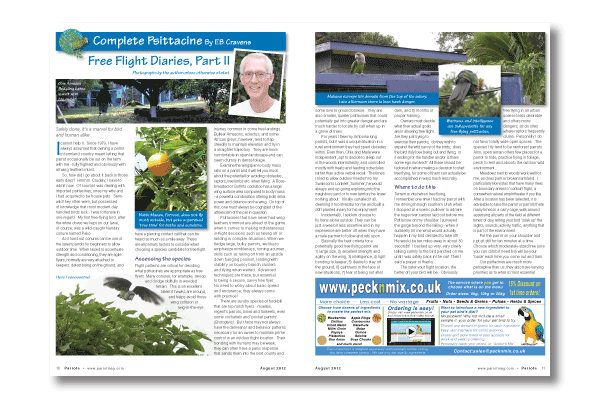
Free Flight Diaries, Part II
I cannot help it. Since 1979, I have always assumed that owning a parrot in farmland country meant letting that parrot occasionally be out on the farm with me - fully flighted and obviously with all wing feathers intact.
So, how did I go about it back in those early days? Hmmm. Crudely, I have to admit now. Of course I was dealing with imported psittacines, ones my wife and I had acquired to be house pets. Semi-wild they often were, but possessed of knowledge that most modern day handfed birds lack. I was fortunate in one regard. My first free-flying bird, after the white doves we kept on our lanai, of course, was a wild-caught Nanday conure named Pako.
As it turns out conures can be one of the safest parrots for beginners to allow outdoor time. When raised to accentuate strength and conditioning, they are agile flyers, normally are very attached to keepers, detest being on the ground, and have a piercing contact call that can be heard as much as a mile away. These are all primary factors to consider when choosing a species candidate for free flight.
Read more in the magazine…
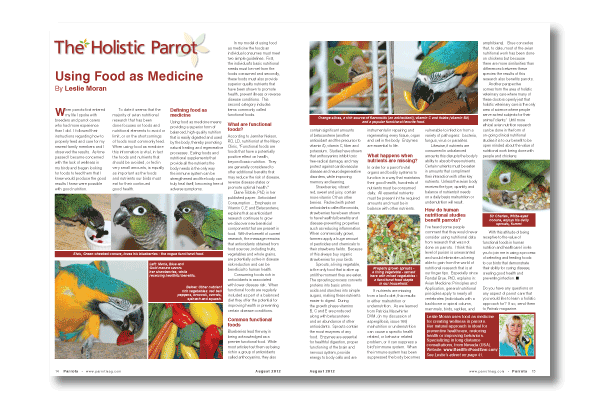
Using Food as Medicine
When parrots first entered my life I spoke with breeders and parrot carers who had more experience than I did. I followed their instructions regarding how to properly feed and care for my newest family members and I observed the results. As time passed I became concerned with the lack of wellness in my birds and began looking for foods to feed them that I knew would produce the good results I knew were possible with good nutrition.
To date it seems that the majority of avian nutritional research that has been done focuses on foods and nutritional elements to avoid or limit, or on the shortcomings of foods most commonly feed. When using food as medicine this information is vital, in fact the foods and nutrients that should be avoided, or fed in very small amounts, is equally as important as the foods and nutrients our birds must eat for their continued good health.
Read more in the magazine…
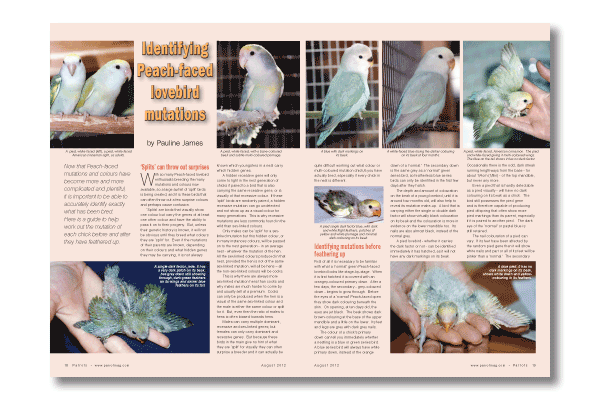
Now that Peach-faced mutations and colours have become more and more complicated and plentiful, it is important to be able to accurately identify exactly what has been bred.
Here is a guide to help work out the mutation of each chick before and after they have feathered up.
‘Splits’ can throw out surprises
With so many Peach-faced lovebird enthusiasts breeding the many mutations and colours now available, so a large surfeit of ‘split’ birds is being created, and it is these birds that can often throw out a few surprise colours and perhaps cause confusion.
‘Splits’ are birds that visually show one colour but carry the genes of at least one other colour and have the ability to pass it on to their progeny. But, unless their genetic history is known, it will not be obvious until they breed what colours they are ‘split’ for. Even if the mutations of their parents are known, depending on their colours and what hidden genes they may be carrying, it is not always known which youngsters in a nest carry which hidden genes.
Read more in the magazine…
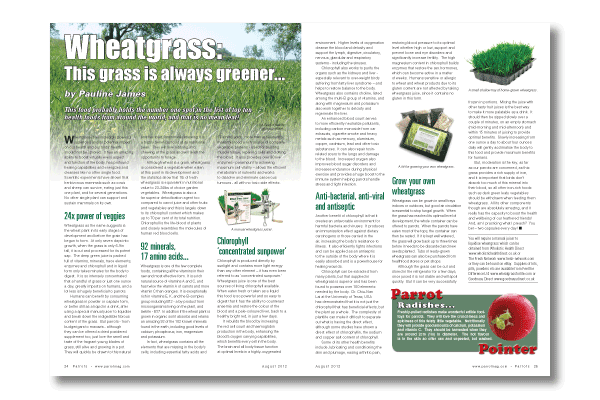
by Pauline James
This food probably holds the number one spot in the list of top ten health foods from around the world, and that is no mean feat!
Wheatgrass is an incredibly powerful superfood and its potential impact on our health and our birds’ health should not be ignored. It has an amazing ability to boost virtually every aspect and function of the body, has profound healing capabilities and energizes and cleanses like no other single food. Scientific experiments have shown that herbivorous mammals such as cows and sheep can survive, eating just this one plant, and for several generations. No other single plant can support and sustain mammals on its own.
Read more in the magazine…
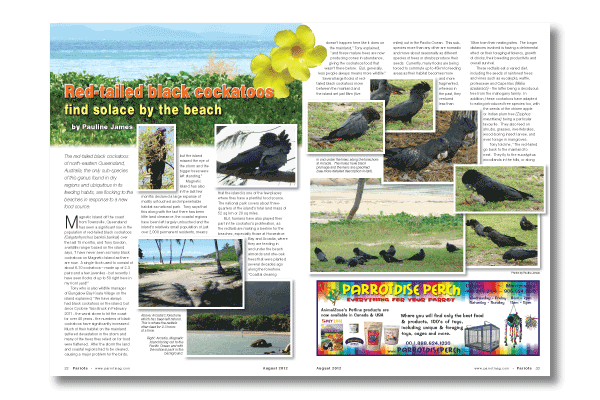
by Pauline James
The red-tailed black cockatoos of north-eastern Queensland, Australia, the only sub-species of this genus found in dry regions and ubiquitous in its feeding habits, are flocking to the beaches in response to a new food source.
Magnetic Island off the coast from Townsville, Queensland has seen a significant rise in the population of red-tailed black cockatoos (Calyptorhynchus banksii banksii) over the last 15 months, and Tony Gordon, a wildlife ranger based on the island says, “I have never seen as many black cockatoos on Magnetic Island as there are now. A single flock used to consist of about 6-10 cockatoos – made up of 2-3 pairs and a few juveniles - but recently I have seen flocks of up to 50 right here in my front yard!”
Tony who is also wildlife manager of Bungalow Bay Koala Village on the island explained, “We have always had black cockatoos on the island, but since Cyclone Yasi struck in February 2011 - the worst storm to hit the coast for over 40 years - the numbers of black cockatoos have significantly increased. Much of their habitat on the mainland suffered devastation in the storm and many of the trees they relied on for food were flattened.
Read more in the magazine…





